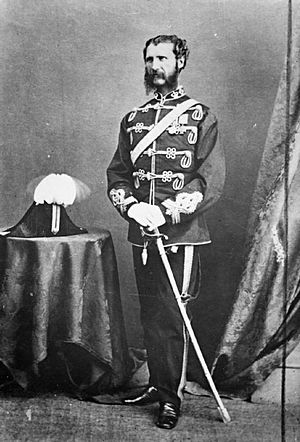Hugh Cochrane facts for kids
Quick facts for kids
Hugh Stewart Cochrane
|
|
|---|---|
 |
|
| Born | 4 August 1829 Fort William, Scotland |
| Died | 23 April 1884 (aged 54) Southsea, Hampshire |
| Buried |
Highland Road Cemetery, Portsmouth
|
| Allegiance | |
| Service/ |
|
| Years of service | 1849–1882 |
| Rank | Colonel |
| Unit | 86th Regiment of Foot 16th Regiment of Foot 7th Regiment of Foot 43rd Regiment of Foot |
| Battles/wars | Indian Mutiny |
| Awards | Victoria Cross |
Colonel Hugh Stewart Cochrane was a very brave soldier who received the Victoria Cross. This is the highest award for courage in the British Army. He was born in Fort William, Scotland, on August 4, 1829. He passed away in Southsea, England, on April 23, 1884.
He earned his Victoria Cross when he was a young officer, a 28-year-old lieutenant. This happened during a major event called the Indian Mutiny. Later in his career, he became a colonel. He even led important army groups like the 43rd Foot.
Contents
A Brave Soldier: Hugh Stewart Cochrane
Hugh Stewart Cochrane joined the British Army in 1849. He served in the 86th (Royal County Down) Regiment of Foot. This group later became part of The Royal Irish Rifles. His army career took him to India.
What Was the Indian Mutiny?
The Indian Mutiny was a big uprising in India that started in 1857. It was a time of great conflict. Many different groups in India fought against British rule. British soldiers like Hugh Stewart Cochrane were sent to help.
Hugh Cochrane's Heroic Actions
On April 1, 1858, Lieutenant Cochrane showed amazing bravery near a place called Jhansi in India. His company was given a tough job. They had to capture a large enemy gun.
Cochrane rode forward very fast. He was under heavy fire from enemy guns and rifles. He bravely charged ahead and drove the enemy away from their gun. He held onto the gun until his company arrived to help.
Later, he showed courage again. He attacked the enemy's rear guard. This was the group protecting the main army from behind. During this fight, three of his horses were shot from under him! But he kept going.
The Victoria Cross Award
For his incredible bravery, Hugh Stewart Cochrane was awarded the Victoria Cross. This award is given for the most outstanding acts of courage. It is for soldiers who show great bravery when facing the enemy. It is the highest award for gallantry in the British and Commonwealth forces.
Later Life and Legacy
After his heroic actions, Hugh Stewart Cochrane continued his military career. He rose through the ranks to become a colonel. He commanded the 43rd Regiment of Foot. He also briefly led the 1st Battalion, Oxfordshire and Buckinghamshire Light Infantry. Colonel Cochrane passed away in 1884. He is buried in Highland Road Cemetery in Portsmouth, England.


